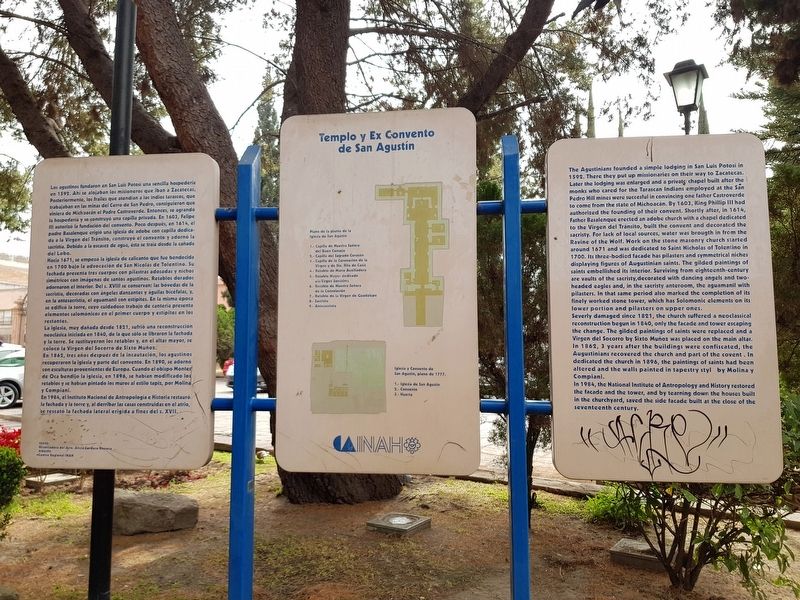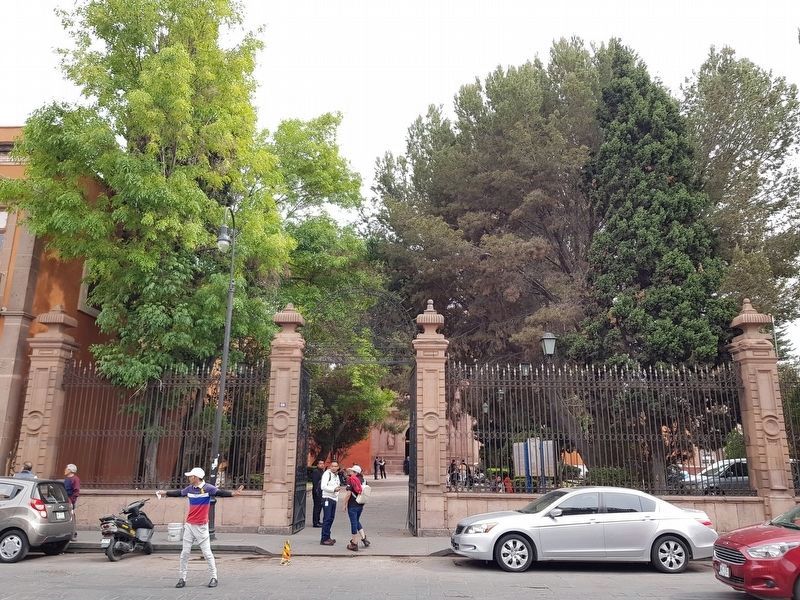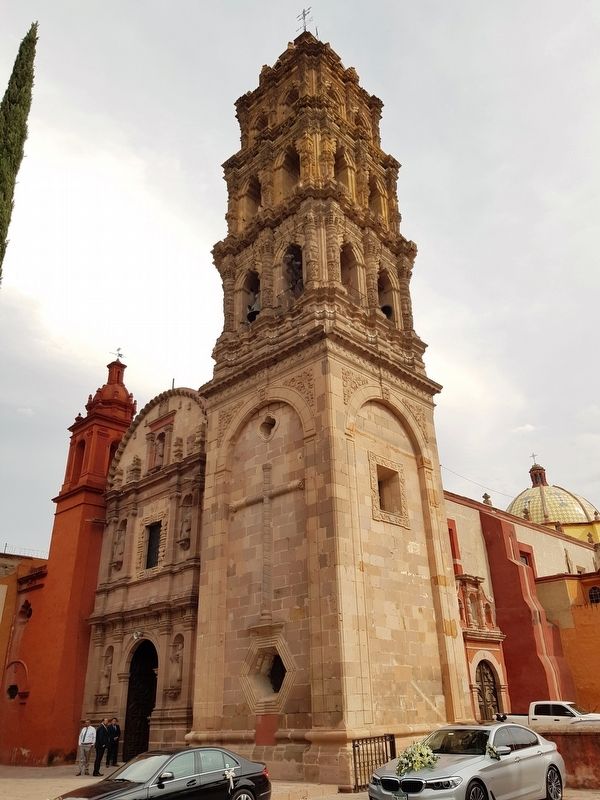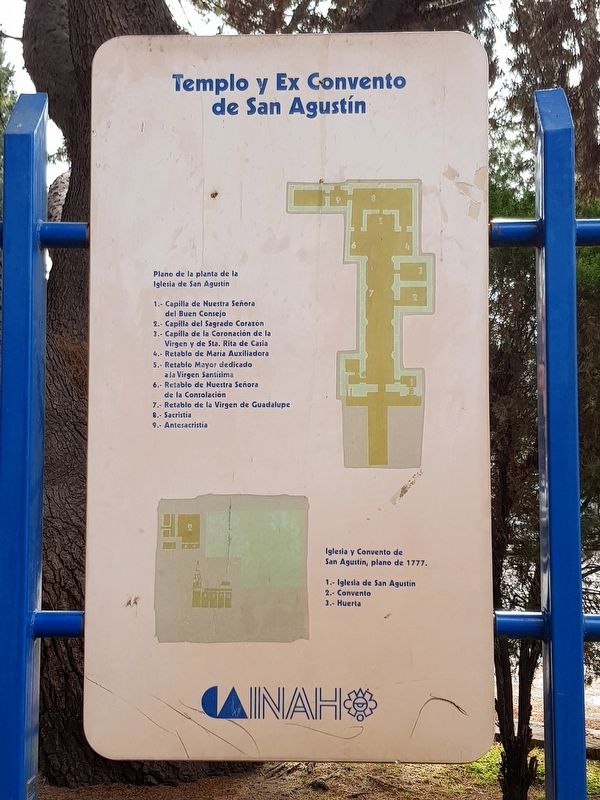San Luis Potosí, Mexico — The Northeast (and Central Highlands)
Temple and Ex-Convent of San Agustín
Inscription.
Los agustinos fundaron en San Luis Potosí una sencilla hospedería en 1592. Ahí se alojaban los misioneros que iban a Zacatecas. Posteriormente, los frailes que atendían a los indios tarascos, que trabajaban en las minas del Cerro de San Pedro, consiguieron que viniera de Michoacán el Padre Castroverde. Entonces, se agrandó la hospedería y se construyó una capilla privada. En 1603, Felipe III autorizó la fundación del convento. Poco después, en 1614, el padre Basalenque erigió una iglesia de adobe con capilla dedicada a la Virgen del Tránsito, construyó el convento y adornó la sacristía. Debido a la escasez de agua, ésta se traía desde la cañada del Lobo.
Hacia 1671, se empezó la iglesia de calicanto que fue bendecida en 1700 bajo la advocación de San Nicolás de Tolentino. Su fachada presenta tres cuerpos con pilastras adosadas y nichos simétricos con imágenes de santos agustinos. Retablos dorados adornaron el interior. Del s. XVIII se conservan: las bóvedas de la sacristía, decoradas con ángeles danzantes y águilas bicéfalas, y en la antesacristía, el aguamanil con estípites. En la misma época se edificó la torre, cuyo cuidadoso trabajo de cantería presenta elementos salomónicos en el primer cuerpo y estípites en los restantes.
La iglesia, muy dañada desde 1821, sufrió una reconstrucción neoclásica iniciada en 1840, de la que sólo se libraron la fachada y la torre. Se sustituyeron los retablos y, en el altar mayor, se colocó la Virgen del Socorro de Sixto Muñoz.
En 1862, tres años después de la incautación, los agustinos recuperaron la iglesia y parte del convento. En 1890, se adornó con esculturas provenientes de Europa. Cuando el obispo Monte de Oca bendijo la iglesia, en 1896, se habían modificado los retablos y se habían pintado los muros al estilo tapiz, por Molina y Compiani.
En 1984, el Instituto Nacional de Antropología e Historia restauró la fachada y la torre y, al derribar las casas construidas en el atrio se rescató la fachada lateral erigida a fines del s. XVII.
Texto: Historiadora del Arte. Alicia Cordero Herrera
Dibujos: Centro Regional INAH
Temple and Ex-Convent of San Agustín
The Agustinians founded a simple lodging in San Luis Potosí in 1592. There they put up missionaries on their way to Zacatecas. Later the lodging was enlarged and a private chapel built after the monks who cared for the Tarascan Indians employed at the San Pedro Hill
mines were successful in convincing one father Castroverde to come from the state of Michoacán. By 1603, King Phillip III had authorized the founding of their convent. Shortly after, in 1614, Father Basalenque erected an adobe church with a chapel dedicated to the Virgen del Tránsito, built the convent and decorated the sacristy. For lack of local sources, water was brought in from the Ravine of the Wolf. Work on the stone masonry church started around 1671 and was dedicated to Saint Nicholas of Tolentino in 1700. Its three-bodied facade has pilasters and symmetrical niches
displaying figures of Augustinian saints. The gilded paintings of saints embellished its interior. Surviving from eighteenth-century are vaults of the sacristy, decorated with dancing angels and two-headed eagles and, in the sacristy anteroom, the aguamanil with pilasters. In that same period also marked the completion of its finely worked stone tower, which has Solomonic elements on its lower portion and pilasters on upper ones.
Severely damaged since 1821, the church suffered a neoclassical reconstruction begun in 1840, only the facade and tower escaping the change. The gilded paintings of saints were replaced and a Virgen del Socorro by Sixto Muñoz was placed on the main altar.
In 1862, 3 years after the buildings were confiscated, the Augustinians recovered the church and part of the covent. In dedicated the church in 1896, the paintings of saints had been altered and the walls painted in tapestry style by Molina y Compiani.
In 1984, the National Institute of Anthropology and History restored the facade and the tower, and by tearing down the houses built in the churchyard, saved the side facade built at the close of the seventeenth century.
Erected by Instituto Nacional de Antropología e Historia (INAH).
Topics. This historical marker is listed in these topic lists: Churches & Religion • Colonial Era • Man-Made Features. A significant historical year for this entry is 1592.
Location. 22° 8.995′ N, 100° 58.46′ W. Marker is in San Luis Potosí. Marker is on Avenida Universidad just east of José María Morelos y Pavón, on the right when traveling east. Touch for map. Marker is at or near this postal address: Avenida Universidad 510, San Luis Potosí 78000, Mexico. Touch for directions.
Other nearby markers. At least 8 other markers are within walking distance of this marker. San Agustin Temple (a few steps from this marker); San Agustín Temple (within shouting distance of this marker); Museum of Masks (about 120 meters away, measured in a direct line); Germán Gedovius Gallery (about 120 meters away); Alarcón Theater (about 120 meters away); Teatro de la Paz (about 150 meters away); Viceregal Art Museum
(about 150 meters away); Temple of Carmen and Ex-Convent of the Barefoot Carmelite Religious Order (about 180 meters away). Touch for a list and map of all markers in San Luis Potosí.
Credits. This page was last revised on April 15, 2019. It was originally submitted on April 15, 2019, by J. Makali Bruton of Accra, Ghana. This page has been viewed 131 times since then and 9 times this year. Photos: 1, 2, 3, 4. submitted on April 15, 2019, by J. Makali Bruton of Accra, Ghana.



